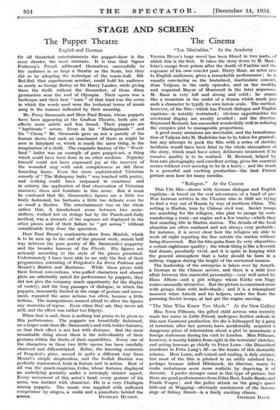STAGE AND SCREEN
The Puppet Theatre English and German OF all theatrical entertainments the puppet-show is the most slender, the most intimate. It is true that Signor Podreeca's Piccoli addressed themselves successfully to the audience in so large a theatre as the Scala, but they did so by adopting the technique of the music-hall. Bil- Bal-Bul, that superhuman acrobat, could hold his audience as surely as George Robey or Sir Harry Lauder, while giving them the thrill, without the discomfort, of those dizzy gymnastics near the roof of Olympia. Their opera was a burlesque and their best " turn " of that kind was the scene in which the words used were the technical terms of music sung in the manner indicated by their meaning.
Mr. Percy Simmonds and Herr Paul Brann, whose puppets have been appearing at the Grafton Theatre, both aim at effects more subtle and less broad. Their puppets are " legitimate " actors. Even in his " Harlequinade " and his " Circus " Mr. Simmonds gave us not a parody of the human shows but such an enactment of them as might be seen in fairyland or, which is much the same thing, in the imagination of a child. The exquisite fantasy of the " Wood- land " ballet was an example of pure puppet-art, a thing which could have been done in no other medium. Nijinsky himself could not have expressed joy at the recovery of the wounded stag with such completeness as did these bounding fauns. Even the more sophisticated Victorian comedy of " The Mahogany Suite " was touched with poetry, and nothing could have surpassed in exactness and in artistry the application of that observation of Victorian manners, dress and furniture in this scene. But it must be confessed that Mr. Simmonds's figures are a little too finely fashioned, his fantasies a little too delicate even for so small a theatre. The entertainment was on the whole rather thin. A knockabout scene between two scene- shifters, worked not on strings but by the Punch-and-Judy method, was a measure of the supreme art displayed in the other pieces and of their failure to " get across " without considerable help from the spectator.
Herr Paul Brann's marionette-show from Munich, which is to be seen up to the end of the present week, stands half way between the pure poetry of Mr. Simmonds's puppetry and the broader humour of the Piccoli. His figures act seriously according to the style of the pieces presented.
Unfortunately I have been able to see only the first of their programmes, consisting of Pergolesi's La Serves Padrona and Mozart's Bastien and Bastienne. While these pieces with their formal conventions, wire-pulled characters and absurd plots are admirably suited for performance by puppets, they did not give the company much opportunity for the display of variety, and the long passages of dialogue, in which the puppets, necessarily limited in the range of gesture and move- ment, repeated the same actions too often, became a little tedious. The manipulators seemed afraid to allow the figures any moments of repose. Even when they sat, they never sat still, and the effect was rather too fidgety.
When that is said, there is nothing but praise to be given to this performance. The puppets are beautifully fashioned, on a larger scale than Mr. Simmonds's and with bolder features, so that their effect is not lost with distance. But the most remarkable thing about them is the individuality of their gestures within the limits of their capabilities. Every one of the characters in these two little operas has been carefully observed and differentiated. Zeline, the knowing soubrette of Pergolesi's piece, moved in quite a different way from Mozart's simple shepherdess, and the foolish Bastien was perfectly represented, both in feature and in action. Best of all was the quack-magician, Colas, whose features displayed an underlying geniality under a seemingly sinister aspect.
Every movement of this actor's head, every gesture of his arms, was instinct with character. He is a very Chaliapin among puppets. The music was supplied with sufficient competence by singers, a violin and a pianoforte behind the







































 Previous page
Previous page